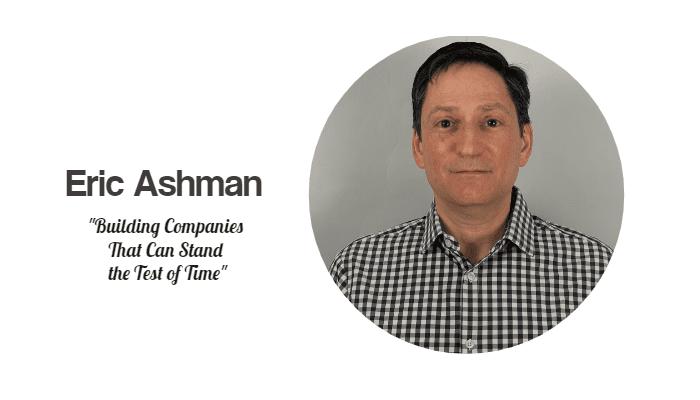Today, we have the opportunity to sit down with Eric Ashman, founder of Bothered Mind Advisors, President of M.M.LaFleur and a member of the advisory board of EforAll Roxbury, to learn a little about his career journey and how to succeed as an entrepreneur.
Entrepreneurship is a powerful force that can lead to the path of self-determination, wealth creation, and a lifetime of fulfillment. Yet we know that most startups fail. Founders struggle with the emotional toll building a company takes. The media lionizes entrepreneurs on the way up, but don’t tell the story of the struggles or the fall back to earth.
There is a better way.
“I have spent my career building companies and helping founders and executive teams realize their vision. My experience is built on the foundation of the seven years as a CPA, and my first attempt at starting a company in 1996,” says Eric Ashman. “Sadly, the company I started, Information Technology Solutions lasted only a year before I closed it down, succumbing to all of the classic mistakes first time founders make in trying to launch a company.”
“Over the next 25 years, I had the opportunity to build great companies, amazing teams, and work through several crises that built the wealth of experience I tap into every day.”
What was your next big break after Information Technology Solutions?
I was appointed to the position of Global CFO of Text 100 Public Relations, an International Technology PR firm, in October of 2000. This timing turned out to be the very top of the Dotcom boom, and the bubble burst soon after my appointment. At the time the company had 29 offices worldwide and over 475 employees. The following few years proved to be an exceptional learning experience as we led the company through that period of upheaval and came out ready for the next leg of growth.
I led the complete restructuring of the business, launching shared services hubs in our North America, EMEA, and APAC regions to streamline operations and improve productivity, opening new offices through licensed affiliates in high growth markets and developing new global compensation strategies that aligned with local and global goals.
Can you tell us about your experience with Huffington Post?
In early 2009, I joined the Huffington Post as the company’s first CFO. This was my first experience in building a high growth, venture capital backed startup. This was a moment in time when digital media was still in the early stages of development as a business. Social media was in its infancy. The company was doubling in size across all of our metrics, including sales and headcount each year. During my time at HuffPost, I grew the operations teams to support our accelerating growth and helped assemble an amazing management team. In 2011, I led the process that resulted in the sale of the company to AOL for $315 million, which at the time represented one of the largest digital media exits. The deal was actually signed at Super Bowl 45, which made for a more exciting half-time show for me and our team.
What did you do next?
Very soon after the sale of HuffPost, I joined Thrillist Media Group as the company’s first CFO. The company had recently acquired JackThreads, a men’s fashion e-commerce company, and both companies were going through a period of rapid growth and change. The company had no operational infrastructure to support our expected growth. I built our finance, HR, legal and analytics teams from the ground up. I also moved the CTO and technology team into my part of the organization, balancing our CEO’s product focus with a methodical approach to technology development and execution that ensured we were constantly aligning available resources with product priorities.
As the CFO, and then later as President of Thrillist Media Group, I led the company through our $13 million Series A in 2012, and a $54 million Series B in 2015. That Series B turned into a simultaneous spin out of JackThreads to split it from our media business, with a separate fundraise for each company from two different groups of investors.
A year later, in 2016, I led the process that raised $100 million in Series C funding from Discovery Communications, coinciding with the simultaneous merger of four digital media companies to create Group Nine Media. Group Nine orginally consisted of four mission-driven, category-leading brands including Thrillist (food, drink & travel), NowThis (news & entertainment), TheDodo (animals & activism) and Seeker (science, tech & exploration). Today, Group Nine also includes Popsugar, which the company acquired in 2019.
From a spin-out to a four company merger within a year is quite a turn. What did you learn from that experience?
More than anything else, I learned that getting a startup through to a level of sustainable, profitable growth requires a tremendous amount of perseverance, and a constant ability to adjust and pivot to reflect changes conditions inside and outside the company.
Building Thrillist from those very early days through to what eventually became Group Nine Media was an intense, amazing and career defining experience. When Thrillist and JackThreads were together, we were defining an entirely new category of Content and Commerce that was unique within the industry. We were building advertising and commerce capacities that were truly unique in a rapidly evolving media and commerce landscape.
But it was the challenges we faced that would come to define the work I would do going forward. JackThreads had launched in 2008, a flash sales, men’s streetwear fashion business that was built on the back of remnant inventory that overflowed due to the impact of the Great Recession on clothing brands around the world. By 2013, as the economy was improving and that remnant inventory dried up, JackThread’s business model was turned upside down, and we went into full blown pivot to try to build a private label business.
Simultaneously, Facebook’s app install and advertising business was going through its first period of maturation, and the cost of customer acquisition was suddenly climbing at an accelerating rate.
By the time we were raising our Series B in 2015, JackThreads was still trying to gain momentum around this pivot, and our first attempt to raise as Thrillist Media Group was struggling to gain traction. This required us to split the companies and execute two simultaneous fundraise processes, one for each company.
The entire process of raising that Series B took nearly a year given its complexity. As Thrillist came out of this process as a standalone company, we quickly realized how quickly the media landscape was shifting and evolving. Consumers were shifting to video consumption on social media platforms, and this wasn’t Thrillist’s strength. Meanwhile, two other companies founded by members of the Lerer family, NowThis News (founded by Ken Lerer) and The Dodo (founded by Izzie Lerer), both had huge scale in video views on social platforms, but very little revenue. By putting the three companies together, we had the potential to create one of the most powerful family of brands in the digital media space. In 2016, Discovery Communications invested $100 million, and contributed their science brand Seeker, to form Group Nine Media.
We were now one of the largest digital media brands in the world, and on the path to sustainable, profitable growth.
I spent the next two years working on the operational integration of the four companies, and with that task essentially completed by mid-2018, it was time to move to my next adventure.
It was around that time that I started Bothered Mind Advisors, an advisory and consultancy helping founders achieve their vision and goals.
Your Pivot to Profitability methodology has been widely praised by startup founders and executives. Can you tell us a little more about your unique approach?
Pivot to Profitability is a framework designed for startups, whether you’re bootstrapping your company or stuck between fundraising rounds with weakening metrics and accelerating cash burn.
There are four parts to the Pivot to Profitability methodology.
Assess: How do you know if you’re off track if you don’t have a map? To properly assess your performance against your goals, you need to define your KPI’s, build your cash forecast, and connect the concept of Innovation Accounting to your financial plan to rapidly iterate your way to profitable growth.
Action: When metrics aren’t meeting your expectations and cash burn is accelerating, you need to take Action before it’s too late. You must identify the parts of your business that aren’t working, make the difficult decisions, address funding gaps, and take care of your employees and your partners.
Advise: Once the tough decisions have been made and acted upon, you need to Communicate with your Employees, Board and Investors to earn their support for the changes you’ve made, and keep them excited about your company’s ongoing opportunity for future growth and success.
Self-Care: The most important aspect of navigating a startup through difficult times, and the topic least discussed, is Self-Care and Founder Mental Health. Being a Founder can be an incredibly lonely journey, with all of the hopes, dreams, and expectations of your Employees, Investors, Family, and Friends falling on your shoulders. You need to develop a toolkit to help you care for yourself and navigate the difficult path you’ve chosen.
What is next for Eric Ashman?
The next 25 years of my career will be built on the foundation of the last 35 years. Being an entrepreneur can be a wonderful experience. But it’s also a difficult and often lonely path. I am going to continue to develop Pivot To Profitability, including the ongoing development of workshops and content that entrepreneurs can use to help build startups that will stand the test of time. I’m excited to be able to work with the advisory board of EforAll in Roxbury as we continue to build the impact and influence of that program. And more than anything else, I’m looking forward to spending as much time as I can mentoring and advising first time entrepreneurs, taking what I’ve learned from my experiences to help them succeed.

































